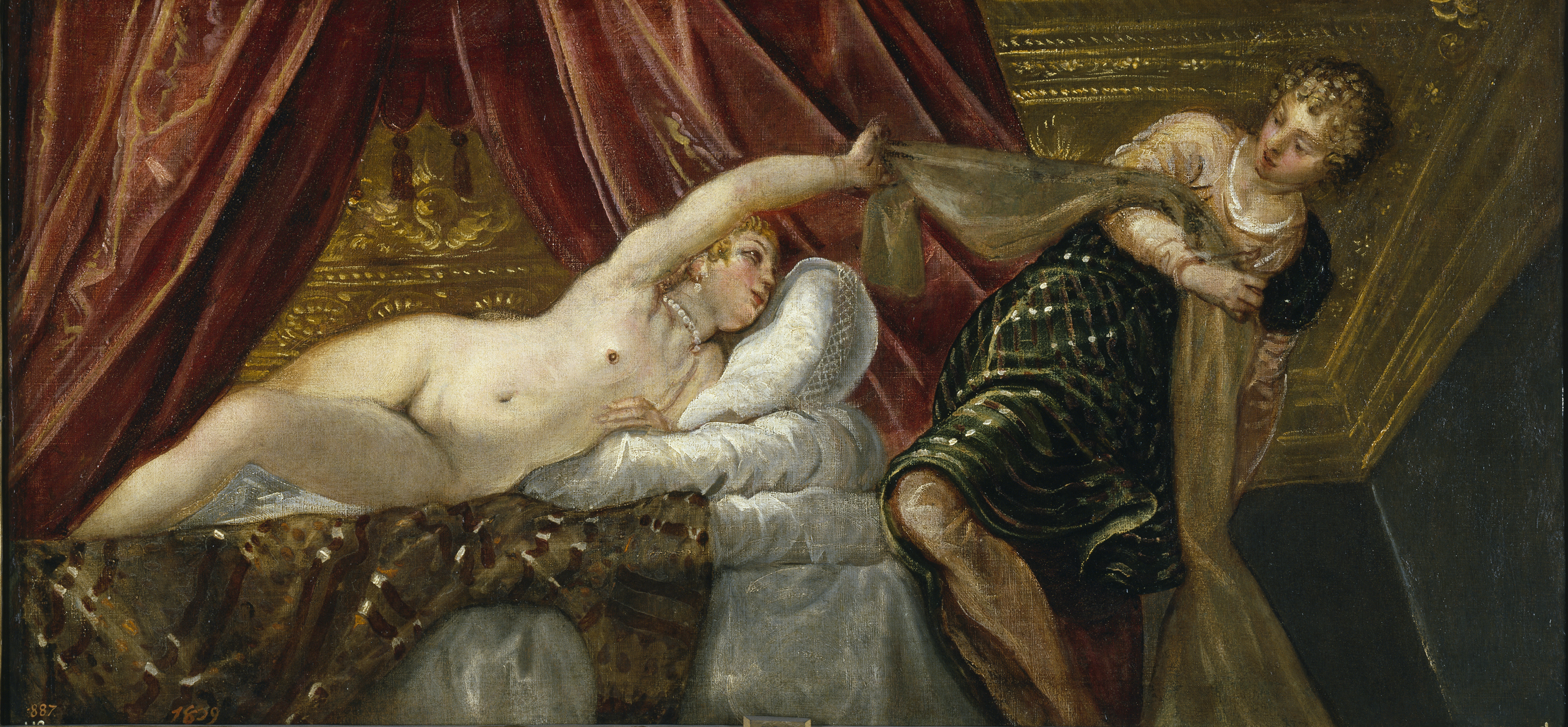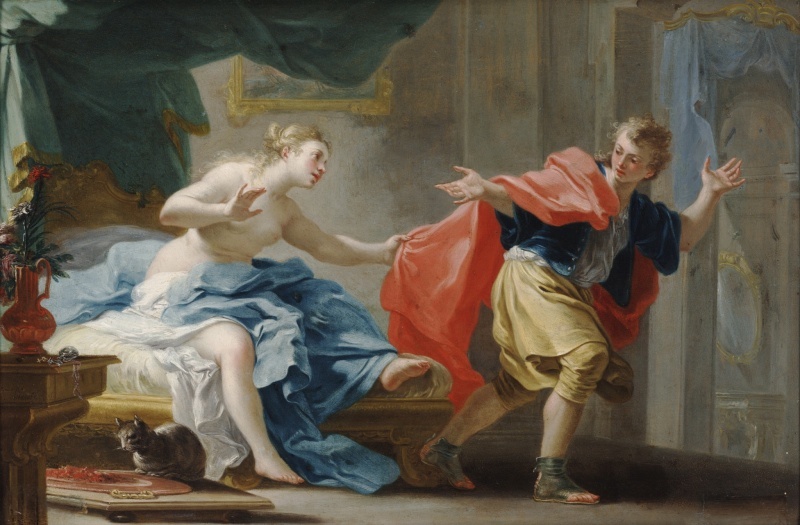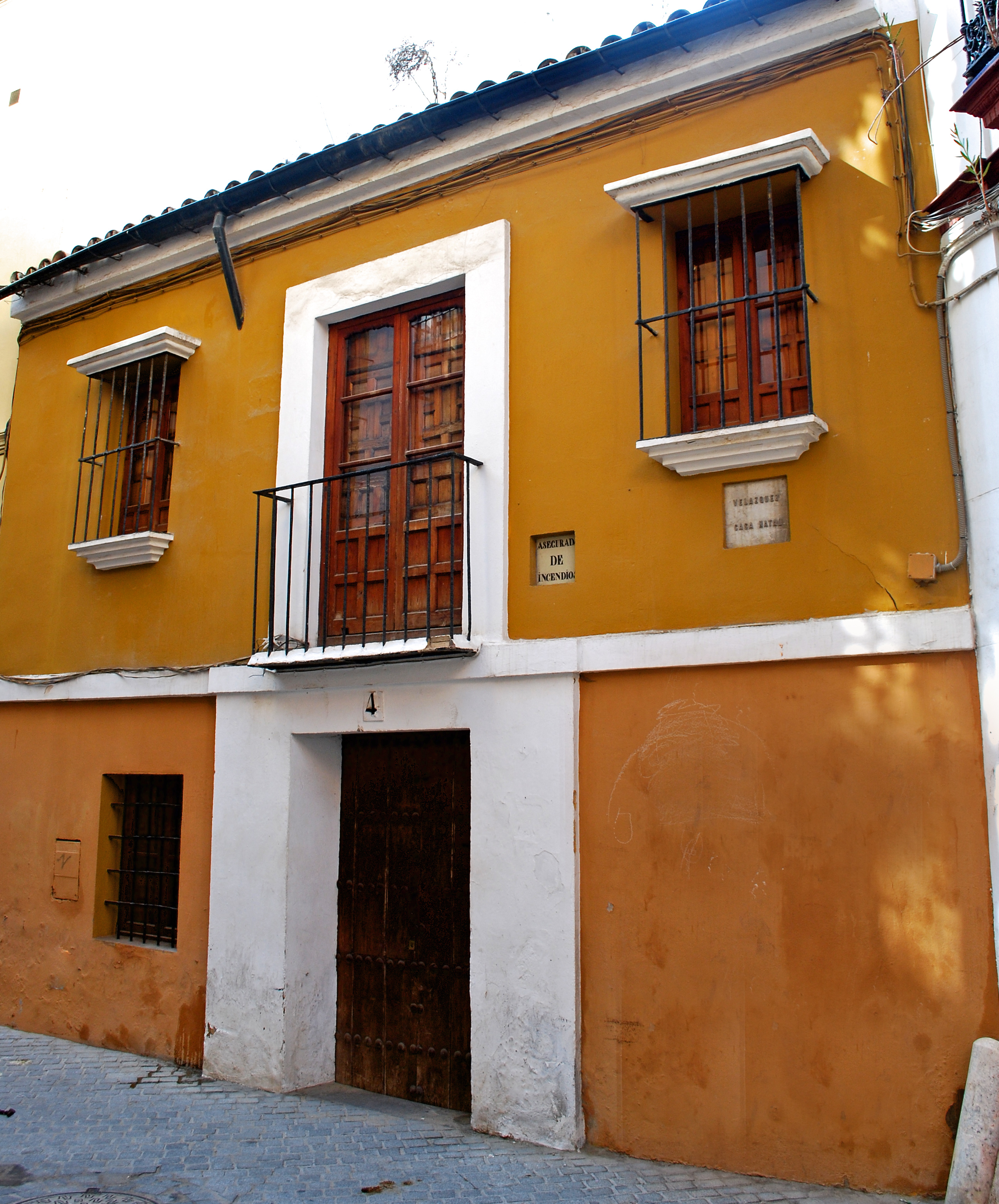|
Joseph And Potiphar's Wife (Tintoretto)
''Joseph and Potiphar's Wife'' is a c. 1555 oil on canvas painting by Jacopo Tintoretto, now in the Museo del Prado, in Madrid. The story of Joseph and Potiphar's wife is from the Old Testament (). It was bought with five other biblical paintings for Philip IV of Spain by Diego Velázquez Diego Rodríguez de Silva y Velázquez (baptized June 6, 1599August 6, 1660) was a Spanish painter, the leading artist in the court of King Philip IV of Spain and Portugal, and of the Spanish Golden Age. He was an individualistic artist of th ... during his second visit to Venice. The viewpoint suggests that it could have adorned a ceiling. It is now in the Museo del Prado in Madrid. See also * Joseph and Potiphar's Wife (other) References {{DEFAULTSORT:Joseph and Potiphar's Wife 1555 paintings Nude art Paintings by Tintoretto Paintings of Joseph and Potiphar's Wife Paintings in the Museo del Prado by Italian artists ... [...More Info...] [...Related Items...] OR: [Wikipedia] [Google] [Baidu] |
Jacopo Tintoretto 018
Jacopo (also Iacopo) is a masculine Italian given name, derivant from Latin ''Iacōbus''. It is an Italian variant of Giacomo. * Jacopo Aconcio (), Italian religious reformer * Jacopo Bassano (1592), Italian painter * Iacopo Barsotti (1921–1987), Italian mathematician * Jacopo da Bologna (), Italian composer * Jacopo Comin (1518–1594), Italian painter otherwise known as Tintoretto * Jacopo Carucci (1494–1557), Italian painter otherwise known as Pontormo * Jacopo Corsi (1561–1602), Italian composer * Jacopo da Leona (died 1277), Italian poet * Jacopo Peri (1561–1633), Italian composer * Jacopo della Quercia (1438), Italian sculptor * Jacopo Riccati (1676–1754), Italian mathematician * Jacopo Sadoleto (1477–1547), Italian Catholic cardinal * Jacopo M. (1989), Italian Communicator, upholder of the European Commission Fictional characters: * Jacopo, a key character in the 2002 film version of ''The Count of Monte Cristo'' (and a minor character in the book ... [...More Info...] [...Related Items...] OR: [Wikipedia] [Google] [Baidu] |
Jacopo Tintoretto
Tintoretto ( , , ; born Jacopo Robusti; late September or early October 1518Bernari and de Vecchi 1970, p. 83.31 May 1594) was an Italian painter identified with the Venetian school. His contemporaries both admired and criticized the speed with which he painted, and the unprecedented boldness of his brushwork. For his phenomenal energy in painting he was termed Il Furioso ("The Furious"). His work is characterised by his muscular figures, dramatic gestures and bold use of perspective, in the Mannerist style. Life The years of apprenticeship Tintoretto was born in Venice in 1518. His father, Battista, was a dyer, or ''tintore''; hence the son got the nickname of Tintoretto, "little dyer", or "dyer's boy". Tintoretto is known to have had at least one sibling, a brother named Domenico, although an unreliable 17th-century account says his siblings numbered 22. The family was believed to have originated from Brescia, in Lombardy, then part of the Republic of Venice. Older studies ga ... [...More Info...] [...Related Items...] OR: [Wikipedia] [Google] [Baidu] |
Museo Del Prado
The Prado Museum ( ; ), officially known as Museo Nacional del Prado, is the main Spanish national art museum, located in central Madrid. It is widely considered to house one of the world's finest collections of European art, dating from the 12th century to the early 20th century, based on the former Spanish royal collection, and the single best collection of Spanish art. Founded as a museum of paintings and sculpture in 1819, it also contains important collections of other types of works. The Prado Museum is one of the most visited sites in the world, and is considered one of the greatest art museums in the world. The numerous works by Francisco Goya, the single most extensively represented artist, as well as by Hieronymus Bosch, El Greco, Peter Paul Rubens, Titian, and Diego Velázquez, are some of the highlights of the collection. Velázquez and his keen eye and sensibility were also responsible for bringing much of the museum's fine collection of Italian masters to Spain, ... [...More Info...] [...Related Items...] OR: [Wikipedia] [Google] [Baidu] |
Madrid
Madrid ( , ) is the capital and most populous city of Spain. The city has almost 3.4 million inhabitants and a metropolitan area population of approximately 6.7 million. It is the second-largest city in the European Union (EU), and its monocentric metropolitan area is the third-largest in the EU.United Nations Department of Economic and Social AffairWorld Urbanization Prospects (2007 revision), (United Nations, 2008), Table A.12. Data for 2007. The municipality covers geographical area. Madrid lies on the River Manzanares in the central part of the Iberian Peninsula. Capital city of both Spain (almost without interruption since 1561) and the surrounding autonomous community of Madrid (since 1983), it is also the political, economic and cultural centre of the country. The city is situated on an elevated plain about from the closest seaside location. The climate of Madrid features hot summers and cool winters. The Madrid urban agglomeration has the second-large ... [...More Info...] [...Related Items...] OR: [Wikipedia] [Google] [Baidu] |
Potiphar's Wife
Potiphar's wife is a figure in the Hebrew Bible and the Quran. She was the wife of Potiphar, the captain of Pharaoh's guard in the time of Jacob and his twelve sons. According to the Book of Genesis, she falsely accused Joseph of attempted rape after he rejected her sexual advances, resulting in his imprisonment. In Genesis she is given no name, but in later medieval Jewish sources and Islamic tradition, she is identified as Zuleikha ( ''zoo-LAY-kah''; ; ar, زُلَيْخَا, translit=zulayḵā). The story of Yusuf and Zulaikha is a popular one in Islamic literature. In Genesis The BibleGenesis 39:5-20 narrates her treatment of Joseph, slave to her husband Potiphar: In Quran The Quran narrates the wife of Aziz’s treatment of Yusuf as follows: Interpretation In Jewish sources Jewish commentators also see some good motives in her actions. A story about Zuleikha is told in Sefer haYashar, where she was mocked by other aristocratic Egyptian ladies, her c ... [...More Info...] [...Related Items...] OR: [Wikipedia] [Google] [Baidu] |
Philip IV Of Spain
Philip IV ( es, Felipe, pt, Filipe; 8 April 160517 September 1665), also called the Planet King (Spanish: ''Rey Planeta''), was King of Spain from 1621 to his death and (as Philip III) King of Portugal from 1621 to 1640. Philip is remembered for his patronage of the arts, including such artists as Diego Velázquez, and his rule over Spain during the Thirty Years' War. By the time of his death, the Spanish Empire had reached approximately 12.2 million square kilometers (4.7 million square miles) in area but in other aspects was in decline, a process to which Philip contributed with his inability to achieve successful domestic and military reform. Personal life Philip IV was born in the Royal Palace of Valladolid, and was the eldest son of Philip III of Spain, Philip III and his wife, Margaret of Austria (1584–1611), Margaret of Austria. In 1615, at the age of 10, Philip was married to 13-year-old Elisabeth of France (1602–1644), Elisabeth of France. Although the ... [...More Info...] [...Related Items...] OR: [Wikipedia] [Google] [Baidu] |
Diego Velázquez
Diego Rodríguez de Silva y Velázquez (baptized June 6, 1599August 6, 1660) was a Spanish painter, the leading artist in the court of King Philip IV of Spain and Portugal, and of the Spanish Golden Age. He was an individualistic artist of the Baroque period (c.1600–1750). He began to paint in a precise tenebrist style, later developing a freer manner characterized by bold brushwork. In addition to numerous renditions of scenes of historical and cultural significance, he painted scores of portraits of the Spanish royal family and commoners, culminating in his masterpiece ''Las Meninas'' (1656). Velázquez's paintings became a model for 19th-century realist and impressionist painters. In the 20th century, artists such as Pablo Picasso, Salvador Dalí, and Francis Bacon paid tribute to Velázquez by re-interpreting some of his most iconic images. Most of his work entered the Spanish royal collection, and by far the best collection is in the Museo del Prado in Madrid, thoug ... [...More Info...] [...Related Items...] OR: [Wikipedia] [Google] [Baidu] |
Joseph And Potiphar's Wife (other)
Joseph and Potiphar's Wife may refer to a number of works based on the story told in Book of Genesis chapter 39: * Joseph and Potiphar's Wife (Properzia de' Rossi), a 1520s marble sculpture by Properzia de' Rossi * Joseph and Potiphar's Wife (Finoglia) - 1620-1623 (or possibly c.1640) painting by Italian artist Paolo Finoglia * Joseph and Potiphar's Wife (Murillo) - 1640–1645 oil on canvas painting by the Spanish artist Murillo * Joseph and Potiphar's Wife (Orazio Gentileschi) - c.1630-1632 painting by the Italian artist Orazio Gentileschi * Joseph and Potiphar's Wife (etching) - 1634 etching by the Dutch artist Rembrandt * Joseph and Potiphar's Wife (Tintoretto) ''Joseph and Potiphar's Wife'' is a c. 1555 oil on canvas painting by Jacopo Tintoretto, now in the Museo del Prado, in Madrid. The story of Joseph and Potiphar's wife is from the Old Testament (). It was bought with five other biblical painti ... - painting by Tintoretto {{disambig ... [...More Info...] [...Related Items...] OR: [Wikipedia] [Google] [Baidu] |
1555 Paintings
Year 1555 ( MDLV) was a common year starting on Tuesday (link will display the full calendar) of the Julian calendar. Events January–June * January 22 – The Kingdom of Ava in Upper Burma falls. * February 2 – The Diet of Augsburg begins. * February 4 – John Rogers suffers death by burning at the stake at Smithfield, London, the first of the Protestant martyrs of the English Reformation under Mary I of England. * February 8 – Laurence Saunders becomes the second of the Marian Protestant martyrs in England, being led barefoot to his death by burning at the stake in Coventry. * February 9 – Rowland Taylor, Rector of Hadleigh, Suffolk, and John Hooper, deposed Bishop of Gloucester, are burned at the stake in England. * April 10 – Pope Marcellus II succeeds Julius III as the 222nd pope. He will reign for 22 days. * April 17 – After 18 months of siege, the Republic of Siena surrenders to the Florentine–Imperial army. * May 2 ... [...More Info...] [...Related Items...] OR: [Wikipedia] [Google] [Baidu] |
Nude Art
The nude, as a form of visual art that focuses on the unclothed human figure, is an enduring tradition in Western art. It was a preoccupation of Ancient Greek art, and after a semi-dormant period in the Middle Ages returned to a central position with the Renaissance. Unclothed figures often also play a part in other types of art, such as history painting, including allegorical and religious art, portraiture, or the decorative arts. From prehistory to the earliest civilizations, nude female figures are generally understood to be symbols of fertility or well-being. In India, the Khajuraho Group of Monuments built between 950 and 1050 CE are known for their erotic sculptures, which comprise about 10% of the temple decorations. Japanese prints are one of the few non-western traditions that can be called nudes, but the activity of communal bathing in Japan is portrayed as just another social activity, without the significance placed upon the lack of clothing that exists in the ... [...More Info...] [...Related Items...] OR: [Wikipedia] [Google] [Baidu] |
Paintings By Tintoretto
Painting is the practice of applying paint, pigment, color or other medium to a solid surface (called the "matrix" or "support"). The medium is commonly applied to the base with a brush, but other implements, such as knives, sponges, and airbrushes, can be used. In art, the term ''painting ''describes both the act and the result of the action (the final work is called "a painting"). The support for paintings includes such surfaces as walls, paper, canvas, wood, glass, lacquer, pottery, leaf, copper and concrete, and the painting may incorporate multiple other materials, including sand, clay, paper, plaster, gold leaf, and even whole objects. Painting is an important form in the visual arts, bringing in elements such as drawing, composition, gesture (as in gestural painting), narration (as in narrative art), and abstraction (as in abstract art). Paintings can be naturalistic and representational (as in still life and landscape painting), photographic, abstract ... [...More Info...] [...Related Items...] OR: [Wikipedia] [Google] [Baidu] |
Paintings Of Joseph And Potiphar's Wife
Painting is the practice of applying paint, pigment, color or other medium to a solid surface (called the "matrix" or "support"). The medium is commonly applied to the base with a brush, but other implements, such as knives, sponges, and airbrushes, can be used. In art, the term ''painting ''describes both the act and the result of the action (the final work is called "a painting"). The support for paintings includes such surfaces as walls, paper, canvas, wood, glass, lacquer, pottery, leaf, copper and concrete, and the painting may incorporate multiple other materials, including sand, clay, paper, plaster, gold leaf, and even whole objects. Painting is an important form in the visual arts, bringing in elements such as drawing, composition, gesture (as in gestural painting), narration (as in narrative art), and abstraction (as in abstract art). Paintings can be naturalistic and representational (as in still life and landscape painting), photographic, abstract ... [...More Info...] [...Related Items...] OR: [Wikipedia] [Google] [Baidu] |

_Casa_di_Tintoretto.jpg)








